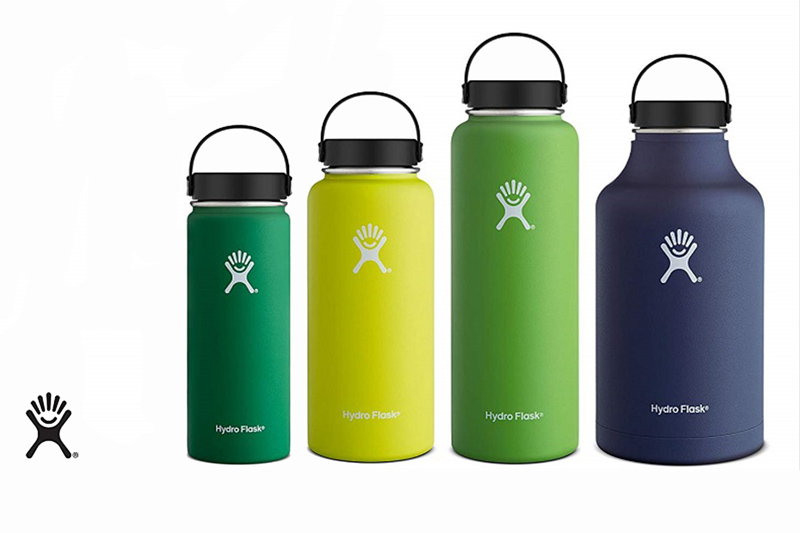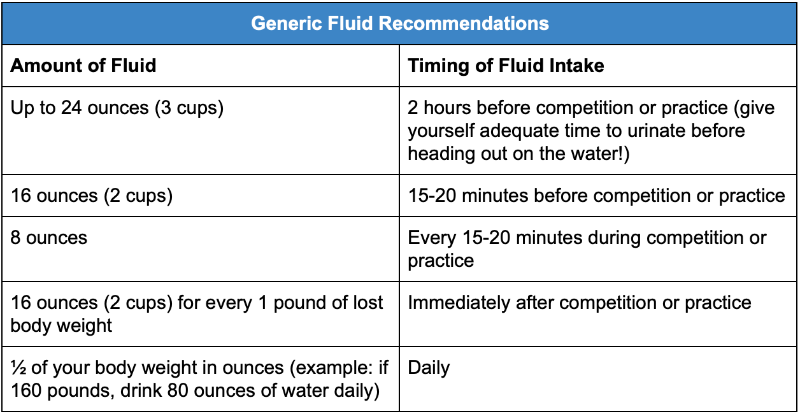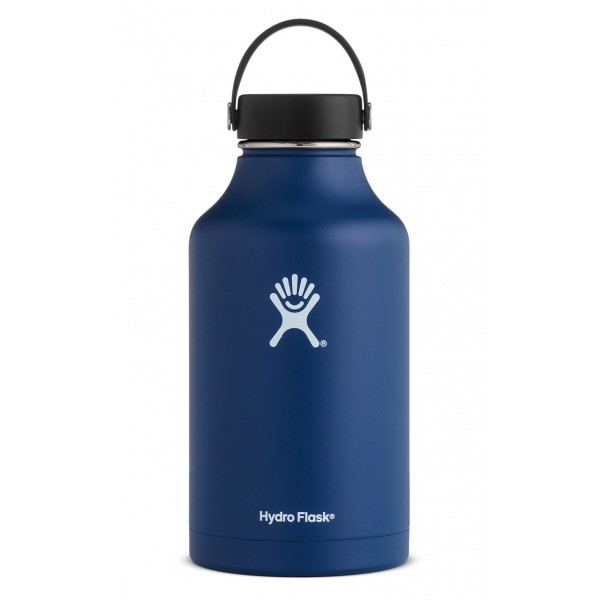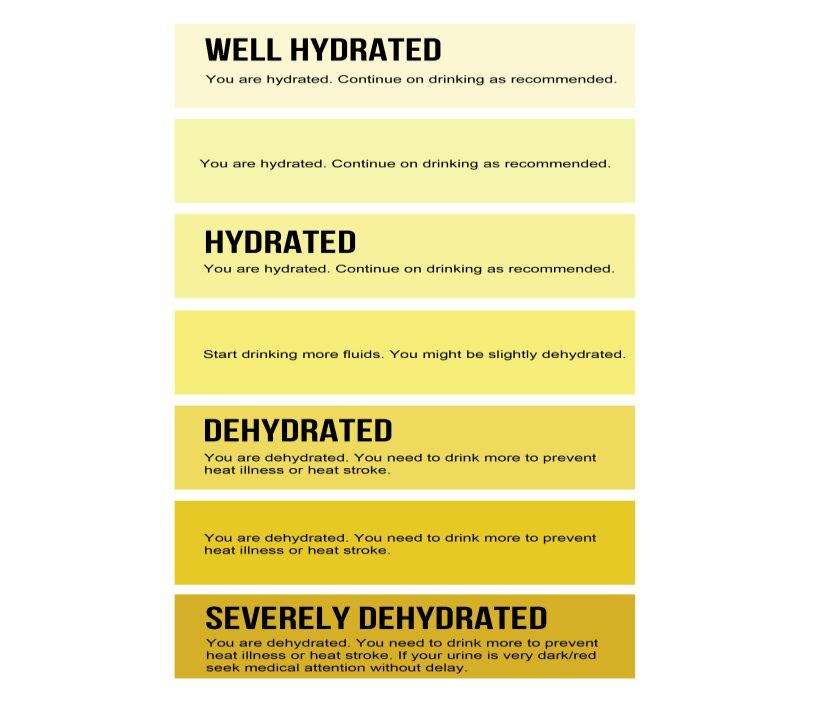
Hydration – What’s it good for?
A reusable water bottle is an essential piece of equipment for every athlete. You can better dial in your hydration habits when consuming out of one type of bottle consistently!
As an athlete, hydration should be one of your primary focuses in your daily nutrition and fitness regimen. Your hydration status is highly important because approximately 60% of your body weight is water, which supports cellular function throughout your entire body. Hydration is one of the most important components to a sailor’s nutrition plan because even slight dehydration can significantly impair athletic performance. Most athletes are cognizant about drinking water while exercising and when it is hot, but many forget about its importance during the rest of the day or in other climates. Remember, you will sweat during hot or cold weather, in the gym, and during outdoor workouts. The amount of sweat lost during training contributes to your total fluid needs. To maximize your athletic performance, you need to be arriving to all training sessions optimally hydrated, which requires you to know your fluid requirements and be responsible for consuming sufficient amounts.
Functions of Water in Your Body:
- Water is the main component of your blood, which carries oxygen, hormones, and nutrients to your cells and muscles.
- Water provides structure, protection, and lubrication to all body parts, joints, and tissues.
- Water helps to remove lactic acid from tired muscles, thus improving recovery.
- Water helps to keep your mind, ears, and vision sharp.
- Water in saliva and gastric secretions helps to digest food
- Water in sweat dissipates heat through the skin – During exercise, water absorbs heat from your muscles, dissipates it through sweat, and regulates your body temperature.
- Water in urine eliminates metabolic waste products – the darker the urine, the more concentrated the wastes
Chat with an SPT Coach
“When you get a feeling of thirst, this is your bodies way of telling you that you need to drink. Despite this, as a sailor, you should not rely on thirst alone to drink as thirst is already a sign of dehydration.”
Importance Of Hydration To A Sailor
Being adequately hydrated can aid in the regulation of your body temperature, which can prevent unnecessary elevations to your heart rate; improve your ability to recover from hard strength and conditioning sessions in the gym or sailing sessions on the water; minimize muscle cramps; enhance your cognitive function, decision making abilities, concentration, and motor control; and support and effective immune system.
Fluid Requirements
As with many things in nutrition, there is no one size fits all nutrition recommendation. Your fluid needs are unique from every other sailor and you must consume sufficient fluids to match your daily fluid losses. Many factors influence fluid needs among sailors. These include the level of training, the type of boat you sail, the clothing you wear, the climate of your training/racing, the duration of training, wind speed, etc. In addition, sex plays a big role as men have higher basal fluid needs and often sweat more than women.

Option 2: Water + Electrolytes + Food
This option works well for athletes who don’t tolerate a sports drink or prefer to eat extra food while training. You need to mix an electrolyte tab (such as Nuun) with your water and eat additional quick-to-digest carbohydrates.
As an athlete you’ve likely experienced cramping. If the cramps are related to hydration and electrolyte balance, your body needs sodium and chloride as these are the electrolytes that are lost in highest quantity in your sweat.
Take a moment to calculate how much water you would need to consume during a 3 hour sailing session: 8 ounces every 20 minutes over the course of 3 hours is 72 ounces! That’s more than the 64oz Hydroflask pictured below!

Your fluid needs are increased through exposure to warm or humid weather, living or training in a dry climate, living or training at altitude, and when you’re traveling by airplane. It’s important you plan ahead for these changes so that you can hydrate accordingly.
Your hydration status is based on a simple fluid balance equation that accounts for your intake versus output of fluids. A positive fluid balance occurs when the net intake of all hydrating fluids and foods is more than the fluid output. Whereas a negative fluid balance occurs when the net intake of all hydration is less than the fluid output.

SPT’s platform tracks hydration using a urine scale, shown above, in the athlete’s daily Biometric Diary. Reading your urine is an important part of athlete body awareness.
Calculating Individual Sweat Rates
Because of your unique fluid needs, it’s important that you calculate your unique sweat rate, which is the amount you will sweat in a given amount of time. Through calculating your sweat rate you will be able to replenish your fluid losses more precisely than the generic recommendations. We suggest calculating your sweat rate on 3 different days in the same climate to get an average for that condition. It’s important to get your sweat rate average for all of the different training/competition scenarios (in the gym, sailing, racing, etc.)
Step 1: Empty your bladder then weigh yourself with as little clothing as possible (preferably naked). Record this weight.
Step 2: Complete at least a 1 hour workout – drink as usual and record how much you drink and how long you exercise.
Step 3: Towel off, get undressed, and weigh yourself again (if wearing clothes, make sure they are the same as pre-workout but make sure they are dry). Record this weight.
Step 4: Subtract your post-workout weight from your pre-workout weight to determine the sweat lost during your workout. Convert pounds of weight lost to ounces. Note, 1 pound of sweat lost = 16 ounces.
Step 5: Add the ounces of sweat lost to the ounces of fluid consumed during your workout. This will produce your total fluid loss.
Step 6: Divide your total fluid loss by the amount of time exercised to determine sweat rate per hour.
Step 7: Next time you workout, know that you need to drink x-amount of fluids every hour to remain hydrated. To make this one step easier for you, break it down to how many bottles per hour you need. Break this down further by how many sips of fluids you need to consume in x-amount of minutes (for example when you’re at the coaches boat).
Dehydration
Your body is great at providing you signals that tell you precisely what it needs. When you get a feeling of thirst, this is your bodies way of telling you that you need to drink. Despite this, as a sailor, you should not rely on thirst alone to drink as thirst is already a sign of dehydration. When your body signals that it is thirsty, you have already decreased your fluid status, which can be highly detrimental to your athletic performance. At the time of thirst, you could have already lost up to 1% of your body weight, which corresponds with the need for your heart to beat an additional 3-5 times per minute, which contributes to increased fatigue. If you lose 2% or more of your body weight, your performance will be significantly hurt and you could develop heat exhaustion or eventually heat stroke. Keep in mind that any weight you lose during exercise represents fluid loss NOT fat loss! As previously mentioned, sweating is your body’s primary way of cooling itself while exercising. Ultimately, when you lose more fluid through sweat than is replaced orally through food and drinks, you become dehydrated. Therefore, you must develop a plan and learn to develop regular drinking habits to always maintain adequate hydration status BEFORE you get thirsty.
Signs and Symptoms of Dehydration
- Lack of concentration
- Early fatigue in training/ racing
- High perceived exertion in training
- Trouble tolerating heat
- Delayed recovery
- Muscle cramps
- Headaches
- Nausea and vomiting
- Heart rate elevated above normal response
Mentally exhausted after a few hours of practice? Make sure you are drinking and eating enough to meet the demands of your sport and see if that makes a difference!


